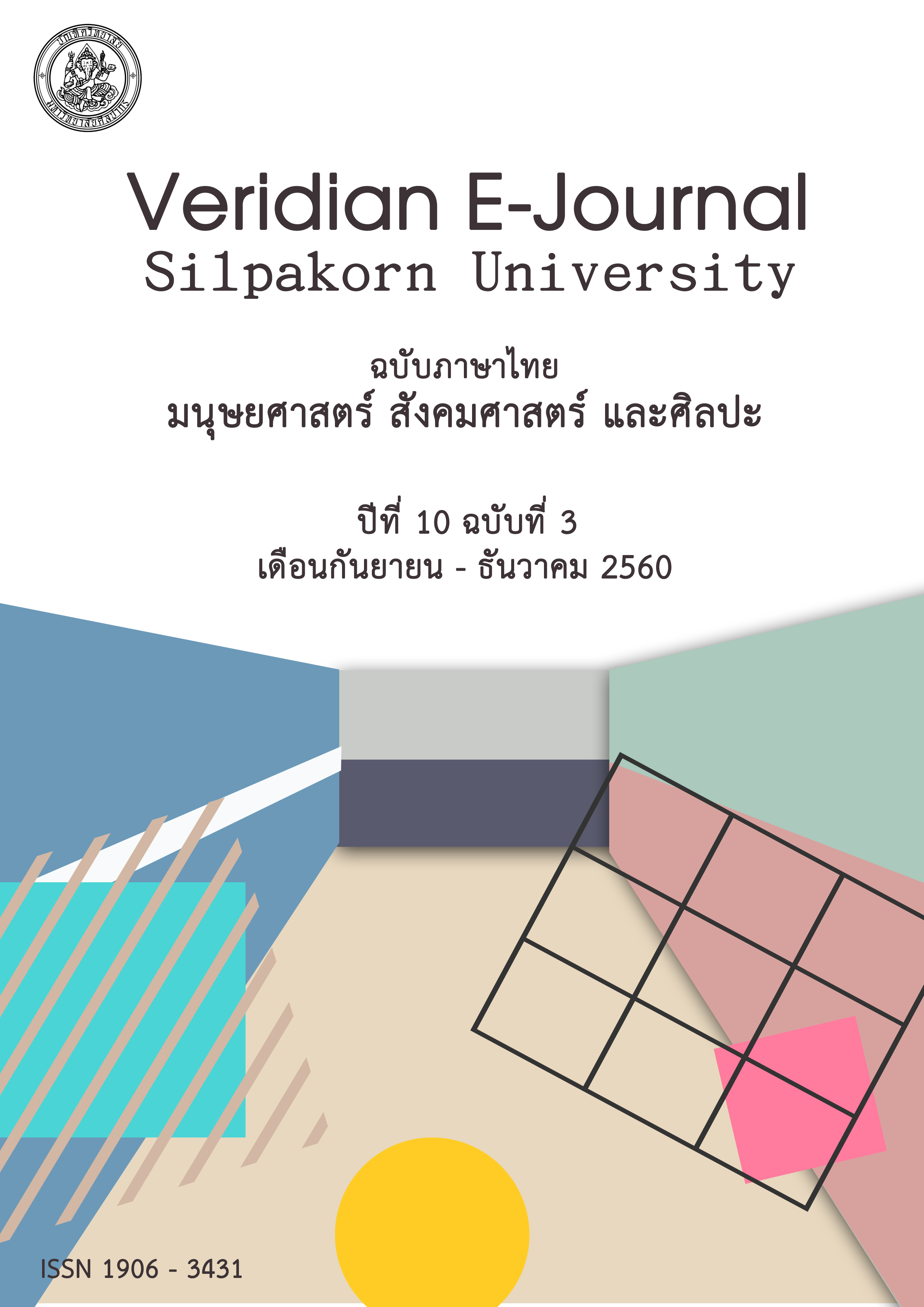การศึกษาโครงสร้างและองค์ประกอบสิ่งแวดล้อมทางธรรมชาติและสิ่งแวดล้อมทางวัฒนธรรมเพื่อการอนุรักษ์และพัฒนาเมืองเก่าสงขลา
Main Article Content
Abstract
การวิจัยมีวัตถุประสงค์เพื่อศึกษา วิเคราะห์ และประเมินคุณค่าความสำคัญของโครงสร้างและองค์ประกอบสิ่งแวดล้อมทางธรรมชาติและทางวัฒนธรรมของเมืองเก่าสงขลา และเพื่อเสนอแนะแนวทางอนุรักษ์และพัฒนาเมืองเก่าสงขลาซึ่งประกอบด้วยเมืองเก่าฝั่งหัวเขาแดง ฝั่งแหลมสน และฝั่งบ่อยาง วิธีการวิจัยใช้วิธีการเก็บรวบรวมข้อมูลจากแหล่งที่เป็นเอกสาร สื่ออิเล็กทรอนิกส์ การสำรวจภาคสนาม และการสำรวจความคิดเห็นด้วยแบบสอบถามจากกลุ่มตัวอย่าง 121 คน ดำเนินการในเดือนพฤษภาคม พ.ศ. 2560 การวิเคราะห์ข้อมูลจากแบบสอบถามด้วยสถิติพรรณนา ค่าเฉลี่ยเลขคณิตและค่าเบี่ยงเบนมาตรฐาน ผู้วิจัยได้จำแนกโครงสร้างและส่วนประกอบของสิ่งแวดล้อมเมืองเก่าสงขลาออกเป็น 4 กลุ่ม ประกอบด้วย กลุ่มที่ 1 สิ่งแวดล้อมทางธรรมชาติ กลุ่มที่ 2 สิ่งแวดล้อมทางวัฒนธรรมที่เป็นรูปธรรม กลุ่มที่ 3 สิ่งแวดล้อมทางวัฒนธรรมที่เป็นนามธรรม และกลุ่มที่ 4 สิ่งแวดล้อมที่เป็นทั้งทางธรรมชาติและทางวัฒนธรรม ผลสรุปจากการวิจัยพบว่า องค์ประกอบที่ได้รับการประเมินคุณค่าความสำคัญสูงสุด ในกลุ่มที่ 1 คือ ทะเลสาบสงขลา พื้นที่ชายฝั่งทะเล แหลมสนอ่อน แหลมสมิหลา หาดชลาทัศน์ และเขาตังกวน กลุ่มที่ 2 คือ ย่านเมืองเก่าถนนนครใน ถนนนครนอก และถนนนางงาม กำแพงเมืองสงขลา พิพิธภัณฑสถานแห่งชาติสงขลา ศาลหลักเมือง และพระตำหนักเขาน้อย กลุ่มที่ 3 คือ ประเพณีทำบุญเดือนสิบและประเพณีชักพระ และกลุ่มที่ 4 คือ เจดีย์หลวงบนเขาตังกวน และป้อมปราการ หัวเขาแดง ในการอนุรักษ์และพัฒนาเมืองเก่าสงขลา ผู้วิจัยได้เสนอแนะให้ขยายเขตพื้นที่อนุรักษ์เมืองเก่าให้ครอบคลุมบริเวณสิ่งแวดล้อมที่ได้รับการประเมินคุณค่าความสำคัญสูง นอกเหนือจากย่านเมืองเก่าเดิม การจัดทำแผนผังอนุรักษ์ พัฒนา และผังเมืองเฉพาะในบริเวณเมืองเก่าทั้ง 3 บริเวณ และพื้นที่สำคัญอื่นๆ อาทิ พื้นที่ชายฝั่งทะเล เขาตังกวน และเขาน้อย การสร้างเขตกันชน การกำหนดระยะถ่อยร่นและความสูงของสิ่งก่อสร้างเพื่อมิให้บดบัง ทำลายทัศนียภาพของเมืองเก่าและเส้นขอบฟ้าของเมือง เปิดช่องมองไปยังที่ตั้งสิ่งแวดล้อมล้อมทางธรรมชาติที่สำคัญ รวมถึงการให้ความรู้และประชาสัมพันธ์ให้ผู้คนทั่วไปได้ตระหนักและคำนึงถึงคุณค่าของโครงสร้างและองค์ประกอบสิ่งแวดล้อมทางวัฒนธรรมและทางธรรมชาติ ในการรักษาบริบทของเมืองเก่าสงขลา เพื่อการอนุรักษ์และพัฒนาที่ยั่งยืน
The objectives of this study are to investigate, analyze, and evaluate value and significance of cultural and natural structures and elements for historical context conservation and development of Songkhla Old Town District which is comprised of 3 areas namely; Hua Koa Daeng, Laem Son, and Bo Yang. In conducting the research, employed methods included collecting information from printed documents, electronic sources, and field survey. Value and significance evaluations were gathered from 121 samples by means of questionnaires during May 2017 and performed a statistical analysis using means and standard deviation. Environment structures and components of Songkhla Old Town were categorized into 4 groups; natural environment, tangible cultural environment, intangible cultural environment, and natural and cultural environment. Findings from research are as follow. Elements that were rated highly significance in the first group are Songkhla Lake, shoreline areas of Lam Son-On, Laem Smila, and Chalathas Beach. In the second group are Own Town District of Nakhonnok, Nakhonnai, and Nang Ngam, City Wall, National Museum, City Pillar Shrine, and Khoa Noi Palace. In the third group are Boon Duean Sib and Chak Phra religious events. And in the forth group are Khoa Tang Kuan Pagoda and Hill and Hoa Khoa Deang Fortress and Hill. For conserving and controlling development within Songkhla Old Town District, the researcher recommended concerned authorities to set up a new conservation district boundary to cover environment sites which were rated highly significance beyond the existing boundary. Furthermore, conservation and development as well as specific urban design plans for 3 Old Town areas, SongKhla shoreline areas, Khoa Tang Kuan and Khoa Noi should be formulated. Buffer zones of set-back and building structure height control should be established, in order to preserve old town character and skyline, and to create vista for people to enjoy natural environment attractions. In addition, knowledge and information regarding natural and cultural environment significance should be wildly disseminated to the public for the sake of maintaining continuity of historical and contextual environment in general for sustainable conservation and development, are also recommended.

